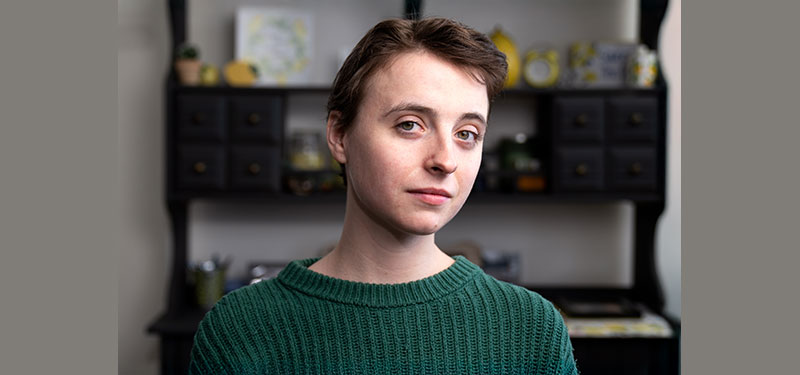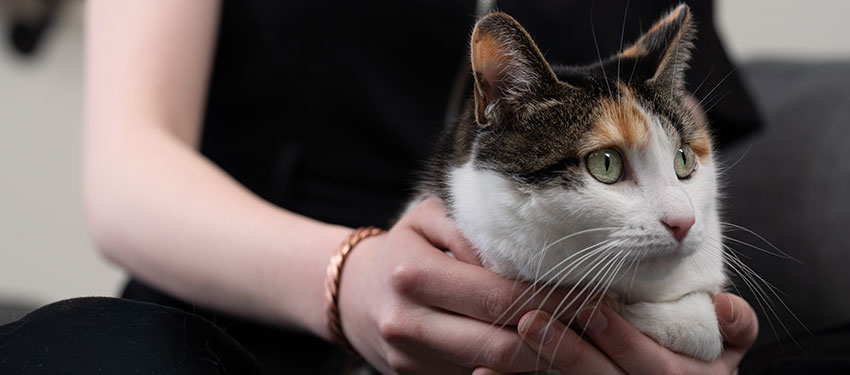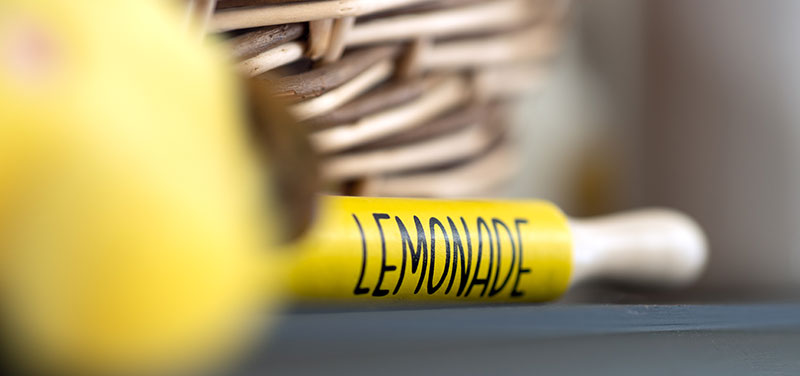Brain cancer patient finds a way forward
by Anna Megdell

Sidney Ritchie
Photo: Erica Reist Bass
Sidney Ritchie’s life changed with her diagnosis of an aggressive brain cancer. Now, in her new reality, she finds meaning and purpose through connection, volunteering, and “showing up fully”
Sidney Ritchie knows her way around the hospital. Before she became a patient at the University of Michigan Health Rogel Cancer Center and C.S. Mott Children’s Hospital in 2024, Sidney was at the start of her career working as a surgical technologist at Michigan Medicine. She found comfort in the bright orderliness of an operating room, in her job’s clear mission to help those in need.
In May 2024 at age 21, Sidney had an MRI to address tingling and numbness, innocuous symptoms her doctors said, “could have been anything.” The MRI was a cautionary measure, not expected to result in anything serious.
After, as Sidney walked to her car, her phone rang. “As soon as my foot hit the pavement in the parking lot, I got a call from my neurologist,” Sidney says. “It was a Friday at 5 p.m. She told me it was very serious, that I had a large brain tumor and needed to go to the emergency room. She said they were expecting me.
“I went numb,” Sidney continues. “I’d worked all day. There was no indication something like this would happen. I wasn’t even nervous before the scan.”
Despite her doctor’s words ringing in her head, Sidney says she still didn’t consider it could be cancer. “But as soon as I got to the ER, they told me, ‘We know this is cancer.’” The MRI revealed a grade 4 diffuse midline glioma with H3K27M mutation, an aggressive form of pediatric brain cancer.
Four days later, Sidney underwent an urgent craniotomy with Wajd Al-Holou, M.D., a neurosurgeon at U-M, to remove the tumor. “I had to be awake for the surgery. Since I was familiar with the inside of an operating room from my job, that part wasn’t as scary as it could have been,” Sidney says.
Sidney’s tumor was located slightly “out of the midline” of her brain, allowing Al-Holou to remove most of it, which is rare for this tumor type.
“The primary site of Sidney’s tumor involved the critical areas of her brain controlling movement. I told Sidney that our best chance to remove this tumor and maintain her normal function was to perform the surgery awake so that we could dissect the tumor away from these critical areas,” says Al-Holou. “This allowed us to resect far more of the tumor than we expected. Since our team here is working to understand why these gliomas are so difficult to treat, we were able to save a part of Sidney’s tumor for this critical research.”
Sidney says her first appointment with Carl Koschmann, M.D., a neuro-oncologist at Mott and clinical scientific director of the U-M Chad Carr Pediatric Brain Tumor Center, two weeks later was a whirlwind. “He told me the concern is tumor recurrence and that we had to start treatment right away. There was no time to waste.”
In addition to radiation, Sidney chose a clinical trial as part of her treatment. “They gave me three options for clinical trials. The first two were placebo trials – there wasn’t a guarantee I’d receive the experimental treatment. I chose the third option,” she says. “It was a no-brainer.”
Sidney’s clinical trial is run through the Children’s Oncology Group with a drug called selinexor, a small molecule inhibitor that has been shown to be very promising in pediatric high-grade glioma.
Although at 22 Sidney is considered a young adult, her type of brain cancer is classified as pediatric. She’s received her care at Mott Children’s Hospital in addition to the Rogel Cancer Center. Patients 21 and younger were eligible for the clinical trial. “I got in by the skin of my teeth,” she says. “This was mid-May 2024. I turned 22 in June.”
Since May, Sidney received 33 radiation treatments with the clinical trial drug and continues to receive the medication weekly. Koschmann says Sidney has responded very well and, “we are hopeful the trial is helpful to slow the return of the tumor.”
He continues, “Sidney is an amazing human being, and I deeply enjoy taking care of her in clinic. She is so smart and so interested in learning about her tumor.”
Still, the relentless schedule can be taxing. “I receive treatment on Monday and Tuesday. It makes me very sick. After a few days, I finally recover just to do it all over again the next week,” she says. “It’s been difficult but I’m still feeling optimistic. I’m taking it day by day.”
The View from Both Sides

Sidney's cat, Paul
Photo: Erica Reist Bass
While undergoing treatment, Sidney has continued to work as a surgical tech at Mott one day a week. “I’ve always been very ambitious and driven, especially in my career. It’s been great to have some normalcy back in my life,” she says. “Some days, I definitely feel like the hospital owns me. Whether it’s for my own care or trying to live normally, I’m doing it all in the same place.
“But I don’t take it for granted,” she continues. “I look at the small things I’m doing every day at work to help another family get over their own hurdles, the same as when I get treatment and people are working so hard to help me and my family. I try to keep a good mindset.”
This duality is woven throughout Sidney’s journey. In addition to balancing both identities as patient and hospital employee, Sidney also straddles a unique experience as a young adult receiving care at the pediatric hospital.
“On one hand, being surrounded by children has been great because they’re so optimistic. It makes me more grateful for what I’ve been able to do in life and inspires me to keep pushing. There’s a lot of hope in pediatrics,” she says. “But there’s also guilt that I’ve been able to experience more than some of the patients around me. It’s both.”
Even with this sense of perspective and gratitude, navigating her diagnosis as an ambitious and independent 22-year-old has been uniquely challenging. “I’m sure it’s hard at all stages,” she said, “but I was in a very particular stage of my life, right on the cusp of making changes and with new, exciting things just over the horizon. I was in a phase of invincibility. I’ve been knocked so far from all of that at once and had to emotionally get a grip on what my new life is for the next few years, if we’re thinking optimistically. This is grade 4 brain cancer. It doesn’t get more of a doozy than that. We’re fighting for longevity. That is hard.”
Sidney copes with this reality by leaning into connection wherever she can find it -- with family and friends, with her cat, Paul, and in her hobbies like knitting and painting. Sidney admits that, initially, she tried to ignore and deny her new reality, but that didn’t last long. “I realized quickly that human connection of any kind is better than wallowing in the sorrow. I try to make the most of normal interactions so I can preserve some emotional well-being even though my life is so different than it was six months ago.”
She’s also navigated the specificity of cancer as a young adult by connecting with other Rogel patients her age through Rogel’s Patient and Family Support Services and the Adolescent and Young Adult Oncology Program at Mott, communities she says have been vital.
“Even the most supportive person can’t really understand what it’s like unless they’ve been there too,” she says. “I’m so grateful I’ve made the most amazing friend who has the same diagnosis and is my age. Those relationships have shaped my treatment. We’re all going through the same nightmare but in different fonts.”
Moving Forward by Giving Back

Photo: Erica Reist Bass
For Sidney, the goals and aspirations that grounded her life before her diagnosis are now “far out of reach,” and having to part ways with that side of her identity and with the self-worth wrapped up in long term career plans that she was prepared to “work really hard for,” has been destabilizing and difficult to comprehend.
But despite the rigor and physical demands of her treatment, Sidney has channeled her inherent sensitivity, ambition and drive into new goals. “I’m working to find meaning in the small things I can do,” she says. “I’m struggling, but I’m getting the job done. That is the goal. I’m focusing on what I can control, which is showing up fully for my treatment and doing everything I can do to help myself.”
In addition to continuing to work at the hospital, Sidney volunteers with Girl Scouts of Southeast Michigan, an organization that shaped her adolescence, mentoring young women to build leadership skills. “I want them to know that having self-worth and self-value is really important,” she says. “Finding connection outside of yourself through community service builds confidence and affirms that you do have value. You can be of service. You bring a lot to the table for yourself and for others.”
Koschmann says Sidney brings this same awareness of others to her treatment approach. “We worked with Dr. Al-Holou to start a tumor ‘organoid’ from additional tissue from her tumor resection and screened it with various drugs. This is all research, but she wanted to know all the details and even asked for picture of her tumor organoid. She is genuinely interested in how her story and tumor samples will help future patients.”
When talking with Sidney, her straightforward authenticity and honesty about the reality of her diagnosis are paired with a sense of gratitude and commitment to her family, community and treatment. She is managing an aggressive disease. Quite often, she refers to how lucky she is.
This feeling blooms most brightly when she speaks about her parents, identical twin sister, Reagan, and younger brother, Nick. “I’ve always been close to my family. Not everyone is as lucky as me. My parents are extremely supportive. My sister was in her senior year of college when I was diagnosed and sacrificed a lot to be there for me. My brother is always upbeat and optimistic. With a phone call, they’d drop everything for me.”
She recalls that first time in the emergency room, sitting with her brother and sister.
“They were talking about what was going on and what needed to be done, and I remember watching them and realizing that their worlds were crumbling along with mine,” she says.
Sidney pauses a moment before continuing. “I’ve learned that I’m really, really tough. If I could undo this, I would in a second, but I’ve learned I’m able to get through hard and harder days, and do it all over again. That drive is because of them. I will do absolutely everything I can, I will crawl and scratch, for any longevity I can have, for them. And I know they’d do the same for me.”
Learn about services available through Rogel’s Adolescent and Young Adult Program
Continue reading Spring 2025 issue of Thrive. Or, download and print the issue.
